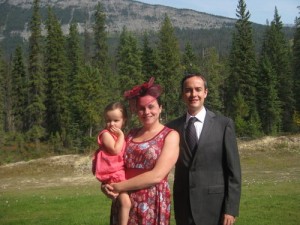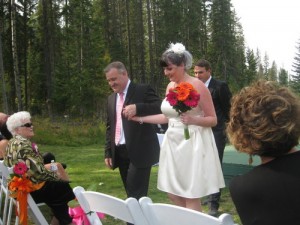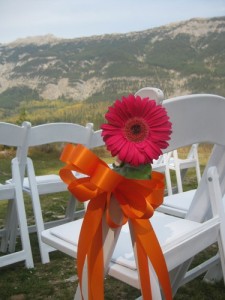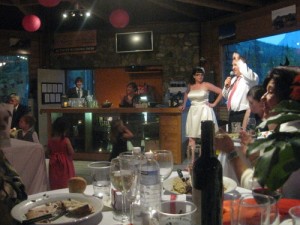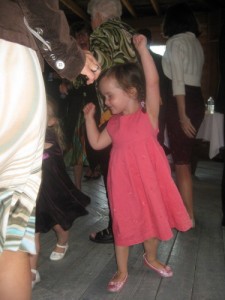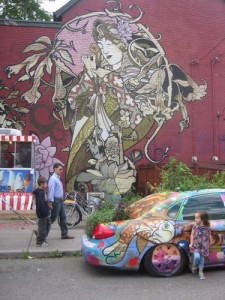September 19, 2012
Cadillac Couches by Sophie B. Watson
 It’s nice when you can tell a book by its cover, in particular when the cover looks like this one. Though I may have always been destined to love Cadillac Couches, the first novel by Sophie B. Watson. After all, it contains the following paragraph: “Eating popcorn and chocolate. Smoking smokes, drinking diet pop. Everything happened in the Cadillac. What larks! But like Bob Geldof asked in one of my favourite books–his autobiography Is that It?–was that it?” But that’s not it, of course, even if it would be enough if it were because I did read Is that It? so many times in high school that its pages fell out and I cut out its pictures (Bob Geldof in overalls) and stuck them on them bedroom wall.
It’s nice when you can tell a book by its cover, in particular when the cover looks like this one. Though I may have always been destined to love Cadillac Couches, the first novel by Sophie B. Watson. After all, it contains the following paragraph: “Eating popcorn and chocolate. Smoking smokes, drinking diet pop. Everything happened in the Cadillac. What larks! But like Bob Geldof asked in one of my favourite books–his autobiography Is that It?–was that it?” But that’s not it, of course, even if it would be enough if it were because I did read Is that It? so many times in high school that its pages fell out and I cut out its pictures (Bob Geldof in overalls) and stuck them on them bedroom wall.
I really liked Cadillac Couches, a silly, sprawling road-trip novel with its very own soundtrack. The story begins at the Edmonton Folk Festival, where music fanatic Annie Jones (“But I didn’t know an arpeggio from an armadillo–I was doomed to be forever a fan, not a player”) decides that the cure for her heartbreak just might be a cross-country road-trip with her best friend Isobel to see Hawksley Workman performing a free show in Montreal. They stop off at the Winnipeg Folk Festival en-route, Annie discovers Ani DiFranco and is half-transformed, they have a breakdown in Wawa, max out their credit cards, and have to busk in order to earn enough money to keep the gas tank topped up. Annie is convinced if they can just make their way to Hawksley that he will fall in love her, and her half-transformation will be complete.
Of course, the road trip narrative one is a familiar one from other books and films, but it fast becomes clear that this one is a road less travelled. There is a bawdiness to Watson’s writing– by page 69, Annie has already masturbated, and also peed in the tub (which her cheating boyfriend gets into as Annie gets out). The narrative itself is meandering, moving in and out of time, referring to other trips that Annie and Isobel have taken together. It’s also scattered with song lyrics, and references to books and movies which Europhiles Annie and Isobel revere. It’s a messy book about messy people, but though it’s sometimes silly, it’s not stupid, and there is substance underneath the whimsy.
Though sometimes it’s too messy in places. Perhaps I’m harping on the Geldof thing, but if Is that It? were one of you’re favourite books, you probably wouldn’t have to say, “And I think I read Paula Yates was a girl just hanging around the music scene when she hooked up with Bob Geldof”. You’d know it. And though Watson herself holds transatlantic status, her character doesn’t, and so it was weird that so much of Annie’s vernacular was made up of Britishisms. I wanted too more of a dynamic between Annie and Isobel (who was suffering a strange fake-bilingual affectation) who seemed strangers to one another, though Watson does do an effective job if showing how travel wears a friendship down.
The novel’s roughness is part of its charm though, underlined by the line drawings throughout and the soundtrack included at the end. The whole package casts a spell. For those of us who came of age in the 1990s, Cadillac Couches is a bit like a scrapbook, the coolest bits of every diary you ever kept. Watson shuns convention with her book’s conclusion too, its happily ever after coming courtesy of a refreshing dose of grrrl power.
September 18, 2012
Mr. King's Things by Genevieve Cote
 I cannot really claim any objectivity in my adoration of Genevieve Cote’s new book Mr. King’s Things, because a character in it was named after my daughter, which is certainly some kind of conflict of interest. I met Genevieve in 2008 on a rather glorious adventure, and we’ve kept in touch ever since, our bond cemented over a mutual love of teapots (she puts them in all her books!) and my admiration for her work. I was 4 months pregnant with Harriet when she signed me a copy of What Elephant?, and since then, Genevieve’s books have made up a beloved corner of our library: her companion books Me and You and Without You, and also The Lady of Shalott. And we’re especially in love with Mr. King’s Things, which arrived in our mailbox yesterday, dedicated, “For the REAL Harriet.”
I cannot really claim any objectivity in my adoration of Genevieve Cote’s new book Mr. King’s Things, because a character in it was named after my daughter, which is certainly some kind of conflict of interest. I met Genevieve in 2008 on a rather glorious adventure, and we’ve kept in touch ever since, our bond cemented over a mutual love of teapots (she puts them in all her books!) and my admiration for her work. I was 4 months pregnant with Harriet when she signed me a copy of What Elephant?, and since then, Genevieve’s books have made up a beloved corner of our library: her companion books Me and You and Without You, and also The Lady of Shalott. And we’re especially in love with Mr. King’s Things, which arrived in our mailbox yesterday, dedicated, “For the REAL Harriet.”
Mr. King is a cat (with a crown) who is fond of buying stuff. When he returns from his shopping excusions, laden with bags and bags of price-tagged goods, he gets rid of his old things by throwing them into a nearby pond. Gone for good, he supposes, but then one day his things return to haunt him in a terrifying way. With the help of his friends (including a small pink owl called Harriet who goes surfing on a paint pallette), Mr. King realizes the error of his ways and learns how old things can be made new.
This book particularly delights me as it contains the line, ‘”A jumble sale!” cries Harriet. “I love jumble sales!”‘ I am not sure that Genevieve deliberately placed a Barbara Pym reference in her picture book, though with the thing she has for teapots, it might not entirely surprise me.
Harriet seems to not think it so remarkable that a character in a book has been named after her, though when you’re 3 years-old, you’re pretty much blase about everything that isn’t a firetruck. Harriet loves the book though, and I’ve read it over and over. Genevieve Cote’s work is as enchanting as ever.
September 17, 2012
Funny September
For me, this time of year is a kind of bookish rapture. The Eden Mills Writers’ Festival, Word on the Street Toronto, and the Victoria College Book Sale are what my Septembers are usually built upon, allowing me to bring home ample inspiration, sunshine memories, and new piles to add to my to-be-read stack. But this year is a bit funny, as my sister had the nerve to put her wedding right in the thick of it, and so now we’re going to be on other side of the country instead of at Word on the Street, and we gave Eden Mills a miss in order to save funds for that trip across the country. Which is all right actually, because my sister’s wedding is going to be wonderful, and I have so many books in my stack that I’m grateful to be put a timezone away from the Vic Book Sale, but it’s been overwhelming getting work done in time for before I go. So this is why you get to read about why I’m really tired, instead of reading about my brilliant time at Eden Mills. But I promise, I’ll be back to all three next year, and it will be a fine reminder to wish my lovely sister a happy anniversary.
September 14, 2012
NW by Zadie Smith
 I don’t remember exactly where or when I purchased White Teeth by Zadie Smith, but I know that it was sometime during that wonderful summer of 2001, when I worked on King Street East and spent my lunch hours in Little York Books and Nicholas Hoare. When I spent the money I was supposed to be saving for my tuition on books instead, stacks and stacks. I bought White Teeth in paperback, and I don’t remember how I heard about it, but I know that it changed my life, my relationship to literature. For the first time, I realized that literature existed beyond survey course syllabi, that great books were being written in the here and now, and by people not much older than I was.
I don’t remember exactly where or when I purchased White Teeth by Zadie Smith, but I know that it was sometime during that wonderful summer of 2001, when I worked on King Street East and spent my lunch hours in Little York Books and Nicholas Hoare. When I spent the money I was supposed to be saving for my tuition on books instead, stacks and stacks. I bought White Teeth in paperback, and I don’t remember how I heard about it, but I know that it changed my life, my relationship to literature. For the first time, I realized that literature existed beyond survey course syllabi, that great books were being written in the here and now, and by people not much older than I was.
Ever after, a new Zadie Smith book has been an event, except perhaps The Autograph Man, which I don’t remember. A Zadie Smith book is one that I have to get in hardback, and so it was with great pleasure that I handed over 30 plus dollars last week at Book City for a copy of her latest, NW. Her first novel since On Beauty from 2005, her first book since the essay collection Changing My Mind in 2010.
From that book, the essay “Rereading Barthes and Nabokov”: “The house rules of a novel, the laying down of the author’s particular terms–all of this is what interests me. This is where my pleasure is.”
The house rules of NW are difficult to discern upon first encounter. This author’s terms are particularly demanding. And yet, when I had to reread the novel’s rather Woolfish first section “Visitation” in an effort to orient myself to Smith’s geography, it was with pleasure, to immerse myself in the text again to understand how Smith has “record[ed] the atoms as they fall upon the mind in the order in which they fall” (so said Woolf herself). A deep, tangled, engaging book, NW has a surface accessibility, streets smooth enough to glide along, but then think too hard and you’re tripped up, pulled down into the Underground. So much going on here (most of it, actually) underneath the surface.
The first section of the book is structured conventionally, a first chapter followed by a second. The narrative itself is loose and elastic, unstuck, unhinged, words played with and pushed into shapes (both literal and figurative). It’s the story of Leah Hanwell who is lying in a hammock in her back garden in North-West London, a nice garden with an apple tree, but it’s still a council flat and not far from the troubled housing estate where Leah had been raised. She hears a phrase on the radio, “I am the sole author of the dictionary that defines me,” and thinks about writing it on the back of her magazine. Her reverie is interrupted by a knock at the door, a manic young woman in a headscarf who’s clutching a utility bill; “I live here,” the girl says, around the corner. She says her mother has been taken to the hospital and she needs money for a cab to get there. She and Leah share a cup of tea in the kitchen, not such a collision of worlds after all. The girl remembers Leah from high school, came through a few years later. Leah gives her 30 pounds and sees her off.
The girl reappears throughout the rest of the section, by chance (because they’re neighbours after all), but Leah becomes obsessed with her. The girl who never paid back the money, who ripped off Leah just as her husband had predicted. Leah, the ginger-haired girl of Irish origin is married to Michel, French by way of Africa, who is determined to progress in his new country, to make his way trading stocks on the internet in the evening. He wants a better life for his children, the children Leah doesn’t want to have. When she discovers she is pregnant, she has an abortion, and Michel has no idea. “Why must love ‘move forward’? Which way is forward?”
The way forward is clear for Felix Cooper in the novel’s second section, its chapters labelled by postcode. Geography is central to Felix’s experience (on the Tube, “Felix established a private space of his own, opening his legs wide and slouching”), the world is not his for the taking and so he has to define his territory. As he moves through the city, his identity is fluid, based on the perceptions of others. Things are looking good for Felix– he has moved away from the estate where he grew up, he’s got work apprenticing with a mechanics, and he’s got a girl who convinces him that anything is possible. He wants a hot car to impress her. He wants to cut ties his past, his mother, his brother, his struggles with addiction, and bad relationships, including one with a creepy Miss Havisham type he just can’t seem to quit. It becomes apparent, however, that however much Felix desires to change his life, he’s forever turning in circles, living out the same scenes and postcodes over and over again.
Next, we meet Natalie Blake, whom we’ve encountered already in the book’s first section, Leah’s friend since childhood. Natalie’s section comprises 185 short paragraphs, numbered. The way forward for Natalie is focussed, fast, propelling her out of the community she came from to academic success in university, a law degree, a successful career, lots of money and marriage and motherhood. We’ve seen Natalie and her husband Frank in their back garden through the eyes of Leah, a world away, barely human in all their polish. And here we are shown beneath the sheen, that Natalie is even more dissatisfied with her own life than Leah is, that her social mobility has left her foundationless, with a life built on aspirations. There is a cost to being the sole author of the dictionary that defines one, or maybe the point is that for some authorship is only an illusory purpose, and how much is missed by years spent becoming rather than simply being.
The pieces of this novel do not fit together neatly, and its characters’ lives are similarly chaotic, sordid, their emotions messy and complex. While I have outlined various pieces of the novel’s plot, to focus on plot too much is to miss the point. NW is a story about city life, about people in proximity and lives rubbing up against one another, roughly and otherwise. It is a novel of impressions, falling atoms and all that, rather than plot. It will also most likely be an entirely different novel each time you read it, as frustrating and challenging as it is illuminating and rich. Noise and melody. And yes, a novel that’s tearing down the house and remaking all the rules.
The pleasure was all mine.
September 14, 2012
It goes on and on.
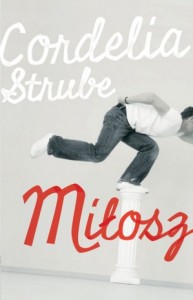 My review of Cordelia Strube’s new novel Milosz appears in the National Post this weekend. As I wrote, “At its heart, which is huge, Milosz is about progeny, about what tethers us to the world and to each other. ” You can the review in its entirety here.
My review of Cordelia Strube’s new novel Milosz appears in the National Post this weekend. As I wrote, “At its heart, which is huge, Milosz is about progeny, about what tethers us to the world and to each other. ” You can the review in its entirety here.
September 11, 2012
The Comics
 It’s true that from a very young age, I read the entire Saturday paper cover-to-cover, if by “the entire Saturday paper” you mean the Toronto Star comics supplement in all its glorious colour. I loved Blondie and Beetle Bailey, Family Circus and For Better or For Worse, The Better Half and Spiderman. I liked Broom Hilda, Dennis the Menace, Hi & Lois, and Hagar the Horrible, though I was confused by Little Orphan Annie because it wasn’t like the movie at all. I was depressed by Jon Arbuckle and Cathy, but read their strips anyway, and all the others I didn’t really understand– Ernie, and Mother Goose and Grimm, Shoe, and many others. In fact, it’s likely that I didn’t understand any of the comics, really, but it didn’t stop me from poring over them every Saturday morning, lying on the living room carpet in my pajamas. There was something in their colours and cartoonishness that made clear that this was my part of the paper; the comics were an invitation and an introduction to the pleasures of newspaper reading.
It’s true that from a very young age, I read the entire Saturday paper cover-to-cover, if by “the entire Saturday paper” you mean the Toronto Star comics supplement in all its glorious colour. I loved Blondie and Beetle Bailey, Family Circus and For Better or For Worse, The Better Half and Spiderman. I liked Broom Hilda, Dennis the Menace, Hi & Lois, and Hagar the Horrible, though I was confused by Little Orphan Annie because it wasn’t like the movie at all. I was depressed by Jon Arbuckle and Cathy, but read their strips anyway, and all the others I didn’t really understand– Ernie, and Mother Goose and Grimm, Shoe, and many others. In fact, it’s likely that I didn’t understand any of the comics, really, but it didn’t stop me from poring over them every Saturday morning, lying on the living room carpet in my pajamas. There was something in their colours and cartoonishness that made clear that this was my part of the paper; the comics were an invitation and an introduction to the pleasures of newspaper reading.
I do love newspapers, inky ones. When we lived in England, we used to buy so many weekend papers that getting them read was our chief occupation. And these days, we subscribe to the ever-shrinking Saturday Globe & Mail, and it’s still one of my favourite parts of Saturday morning, Tabatha Southey, tea, book reviews and croissants.
Lately Harriet’s got her own part of the paper, and she starts shouting for it as soon as I bring the paper in: “Comics! Comics!” Which is kind of funny because The Globe & Mail comics are mostly terrible, but Harriet doesn’t know and doesn’t care. She sees the cartoon pictures, and she thinks they’re for her. And so she makes us read the whole section aloud, some comics over and over. I don’t know if there has ever been a family so intent on Drabble. Sometimes the comics are even less terrible then you’d think, and when that happens, we’re always kind of amazed.
And thankfully, when the comics are too unfunny, we supplement Harriet’s hunger for them with regular trips to our local kids’ comics shop.
September 11, 2012
The Art and Business of Blogging: Fall 2012
 I teach The Art and Business of Blogging at the University of Toronto School of Continuing Studies, and the next session starts on October 2, running for 9 weeks. Here’s the syllabus from last year, if you want an idea of what we’ll be working on. I’m looking forward to it and hoping for a big class of enthusiastic and inquisitive students. Please do spread the word!
I teach The Art and Business of Blogging at the University of Toronto School of Continuing Studies, and the next session starts on October 2, running for 9 weeks. Here’s the syllabus from last year, if you want an idea of what we’ll be working on. I’m looking forward to it and hoping for a big class of enthusiastic and inquisitive students. Please do spread the word!
September 10, 2012
When this is all over…
 The latest in a series of strange objects I’ve found in the road, and actually on the same block as the “another Belfast man doing well” post-it. The story behind this one is even harder to discern, however. It’s actually a broken piece of plaster, painted on one side with a message etched in Sharpie with dubious grammar. I have this feeling it’s leftover from frosh week, as we live close to the university, and in that context, it makes total sense to me. I remember hating frosh week and hating so much about university as an institution, how adulthood was still so elusive, and how the bright spots in my world were a handful of kindred spirits. I probably would have written such a note to any of them, probably not on a piece of broken plaster, but perhaps it was the only surface available. I love how this broken piece of plaster manages to express the same love and longing of The Beach Boys’ Wouldn’t It Be Nice. Though I wonder how it ended up in the road, if the longing was unrequited, and the plaque’s recipient had had plans to get an apartment with another person altogether…
The latest in a series of strange objects I’ve found in the road, and actually on the same block as the “another Belfast man doing well” post-it. The story behind this one is even harder to discern, however. It’s actually a broken piece of plaster, painted on one side with a message etched in Sharpie with dubious grammar. I have this feeling it’s leftover from frosh week, as we live close to the university, and in that context, it makes total sense to me. I remember hating frosh week and hating so much about university as an institution, how adulthood was still so elusive, and how the bright spots in my world were a handful of kindred spirits. I probably would have written such a note to any of them, probably not on a piece of broken plaster, but perhaps it was the only surface available. I love how this broken piece of plaster manages to express the same love and longing of The Beach Boys’ Wouldn’t It Be Nice. Though I wonder how it ended up in the road, if the longing was unrequited, and the plaque’s recipient had had plans to get an apartment with another person altogether…

